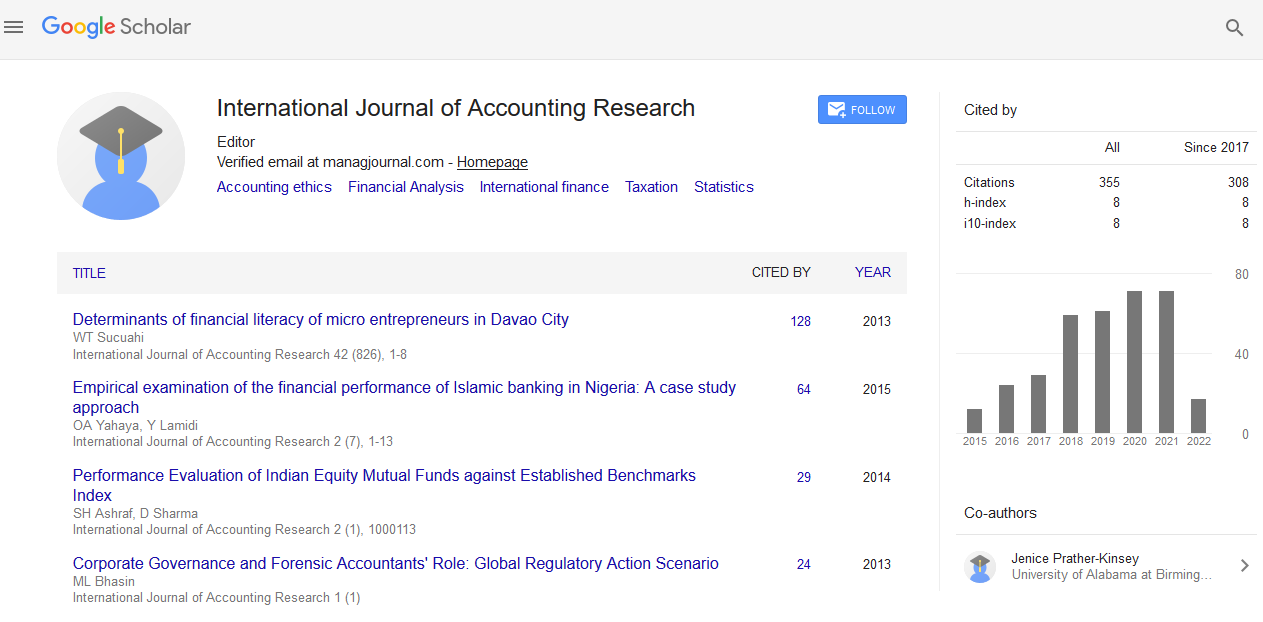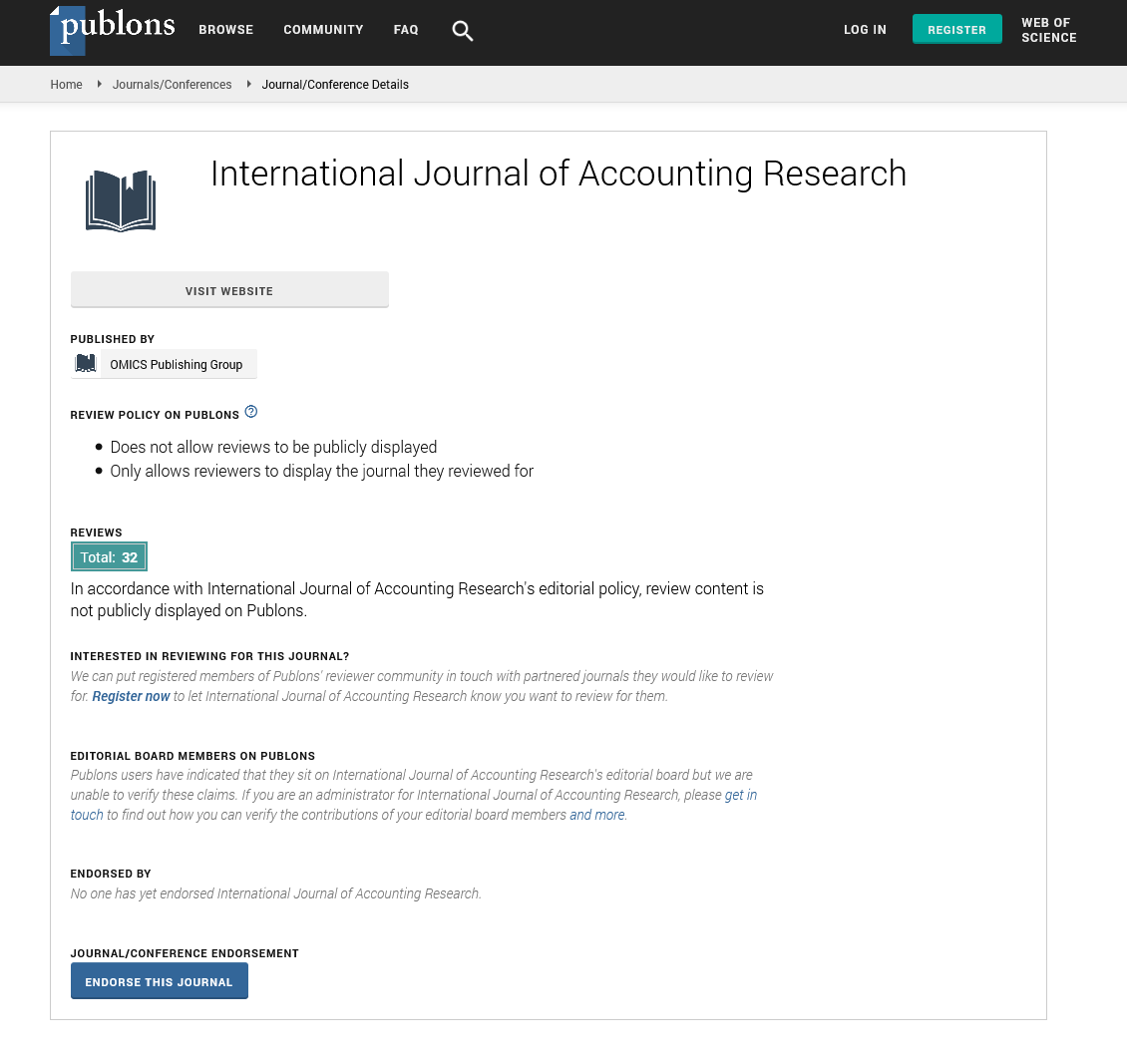Indexed In
- Open J Gate
- RefSeek
- Hamdard University
- EBSCO A-Z
- Scholarsteer
- Publons
- Euro Pub
- Google Scholar
Useful Links
Share This Page
Journal Flyer

Open Access Journals
- Agri and Aquaculture
- Biochemistry
- Bioinformatics & Systems Biology
- Business & Management
- Chemistry
- Clinical Sciences
- Engineering
- Food & Nutrition
- General Science
- Genetics & Molecular Biology
- Immunology & Microbiology
- Medical Sciences
- Neuroscience & Psychology
- Nursing & Health Care
- Pharmaceutical Sciences
Perspective - (2023) Volume 11, Issue 2
Unveiling the Synchronization Dynamics in Hyperchaotic Financial Markets
Serpell Pelger*Received: 27-Mar-2023, Manuscript No. IJAR-23-21410; Editor assigned: 29-Mar-2023, Pre QC No. IJAR-23-21410 (PQ); Reviewed: 14-Apr-2023, QC No. IJAR-23-21410; Revised: 21-Apr-2023, Manuscript No. IJAR-23-21410 (R); Published: 28-Apr-2023, DOI: 10.35248/2472-114X.23.11.329
Description
Financial markets are complex systems that exhibit intricate dynamics and interactions among various elements. These systems are influenced by a multitude of factors, including economic indicators, investor sentiment, and policy changes. Understanding and predicting the behavior of financial markets is a challenging task due to their nonlinear nature and the presence of chaotic dynamics. Hyperchaos, a phenomenon characterized by multiple coexisting chaotic attractors, adds another layer of complexity to these systems. This article explores the concept of synchronization in hyperchaotic finance systems, shedding light on the underlying mechanisms and potential implications.
Defining hyperchaos in finance systems
Chaotic behavior is often associated with unpredictability, sensitivity to initial conditions, and the absence of long-term regular patterns. In financial systems, hyperchaos refers to the presence of multiple chaotic attractors. These attractors coexist and interact, leading to a highly complex and unpredictable behavior. Hyperchaos can emerge in financial models that incorporate multiple factors, such as market sentiment, interest rates, exchange rates, and other economic variables.
Synchronization: Unveiling order in chaos
Synchronization is a phenomenon that occurs when two or more chaotic systems adjust their states to achieve a common behavior. In the context of hyperchaotic finance systems, synchronization can bring about a form of order amidst the inherent chaos. The synchronization of financial variables can lead to the emergence of collective dynamics, which can have significant implications for market participants and policymakers.
Types of synchronization
There are different types of synchronization that can manifest in hyperchaotic finance systems:
Complete synchronization: In this scenario, all the chaotic variables of two or more systems evolve in unison, aligning their trajectories. This form of synchronization implies that the systems become indistinguishable from each other, exhibiting the same dynamics.
Generalized synchronization: Generalized synchronization occurs when the systems achieve a consistent relationship, despite not having identical trajectories. The relationship can be defined by a mathematical transformation that links the variables of the different systems, allowing for predictions and control.
Lag synchronization: Lag synchronization involves the synchronization of the states of two systems, but with a time delay between them. This delay can have practical implications for trading strategies and decision-making processes in financial markets.
Anticipated synchronization: Anticipated synchronization is a phenomenon where one system synchronizes with the future behavior of another system. This type of synchronization can be particularly relevant in predicting market movements and making informed investment decisions.
Applications and implications
The synchronization of hyperchaotic finance systems carries several practical applications and implications:
Risk management: Understanding synchronization patterns in financial systems can provide valuable insights for risk management. By identifying the interdependencies and synchronization among various market variables, financial institutions can better assess systemic risks and develop effective hedging strategies.
Market predictability: Synchronization patterns can help uncover hidden relationships and predict market movements. By studying the synchronization between leading indicators and financial variables, analysts can gain a deeper understanding of market dynamics and improve forecasting accuracy.
Portfolio diversification: Synchronization analysis can aid in portfolio diversification strategies. By identifying variables that exhibit weak or no synchronization, investors can build portfolios with reduced exposure to correlated risks, potentially enhancing risk-adjusted returns.
Financial regulation: Synchronization analysis can inform policymakers about the systemic risks present in financial markets. By understanding the synchronization patterns among key variables, regulators can design policies and interventions to mitigate the amplification of shocks and maintain stability.
Challenges and future directions
While the concept of synchronization in hyperchaotic finance systems holds great potential, several challenges and avenues for future research exist:
Data limitations: Accurate and high-frequency data are crucial for analyzing synchronization in financial markets. Obtaining such data can be challenging, as financial data is often noisy, incomplete, or subject to delays. Overcoming these limitations and developing robust data collection methods will be essential for advancing the understanding of synchronization in hyperchaotic finance systems.
Modeling complexity: Developing accurate models that capture the hyperchaotic dynamics of financial systems is another area of research. These models should incorporate the nonlinear interactions and multiple attractors that characterize hyperchaotic behavior. Improving model accuracy will contribute to a better understanding of synchronization patterns and their implications.
Risk assessment: Assessing the risks associated with synchronization in hyperchaotic finance systems is a critical aspect. Identifying potential vulnerabilities and systemic risks arising from synchronization is crucial for financial stability. Enhancing risk assessment frameworks to incorporate synchronization analysis will aid in proactive risk management and mitigation strategies.
Network analysis: Studying financial markets as interconnected networks can provide insights into synchronization patterns. Analyzing the structure and dynamics of financial networks can help identify influential nodes, transmission channels, and the impact of synchronization on the overall system resilience. Network-based approaches offer a promising avenue for understanding the complexities of hyperchaotic finance systems.
Technological advancements: Advances in computational power and data analytics techniques can greatly facilitate the analysis of synchronization in hyperchaotic finance systems. Machine learning algorithms, artificial intelligence, and big data analytics can assist in identifying complex patterns, relationships, and synchronization dynamics that may not be apparent through traditional approaches.
Citation: Pelger S (2023) Unveiling the Synchronization Dynamics in Hyperchaotic Financial Markets. Int J Account Res. 11:329.
Copyright: © 2023 Pelger S. This is an open-access article distributed under the terms of the Creative Commons Attribution License, which permits unrestricted use, distribution, and reproduction in any medium, provided the original author and source are credited.


